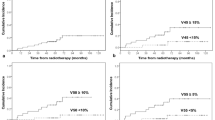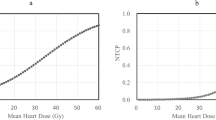Abstract
Purpose
To evaluate the dose–volume parameters of the pericardium and heart in order to reduce the risk of radiation-induced pericardial effusion (PE) and symptomatic PE (SPE) in esophageal cancer patients treated with concurrent chemoradiotherapy.
Methods
In 86 of 303 esophageal cancer patients, follow-up CT was obtained at least 24 months after concurrent chemoradiotherapy. Correlations between clinical factors, including risk factors for cardiac disease, dosimetric factors, and the incidence of PE and SPE after radiotherapy were analyzed using Cox proportional hazard regression analysis. Significant dosimetric factors with the highest hazard ratios were investigated using zones separated according to their distance from esophagus.
Results
PE developed in 49 patients. Univariate analysis showed the mean heart dose, heart V5–V55, mean pericardium dose, and pericardium V5–V50 to all significantly affect the incidence of PE. Additionally, body surface area was correlated with the incidence of PE in multivariate analysis. Grade 3 and 4 SPE developed in 5 patients. The pericardium V50 and pericardium D10 significantly affected the incidence of SPE. The pericardium V50 in patients with SPE ranged from 17.1 to 21.7%. Factors affecting the incidence of SPE were the V50 of the pericardium zones within 3 cm and 4 cm of the esophagus.
Conclusion
A wide range of radiation doses to the heart and pericardium were related to the incidence of PE. A pericardium V50 ≤ 17% is important to avoid symptomatic PE in esophageal cancer patients treated with concurrent chemoradiotherapy.
Zusammenfassung
Ziel
Beurteilung der Dosis-Volumen-Parameter für Perikard und Herz zur Risikoreduzierung eines strahleninduzierten Perikardergusses (PE) und eines symptomatischen PE (SPE) bei mit kombinierter Strahlenchemotherapie behandelten Speiseröhrenkrebspatienten.
Methoden
Bei 86 von 303 Speiseröhrenkrebspatienten wurde mindestens 24 Monate nach der Strahlenchemotherapie ein Kontroll-CT angefertigt. Die Korrelationen zwischen klinischen Faktoren, einschließlich Risikofaktoren für Herzerkrankungen, dosimetrischen Faktoren und der Inzidenz eines PE und SPE nach Strahlentherapie wurden mittels proportionaler Cox-Regressionsanalyse analysiert. Signifikante dosimetrische Faktoren mit den höchsten Hazard Ratios wurden unter Verwendung des Bereichs, der entsprechend dem Abstand vom Ösophagus abgegrenzt wurde, untersucht.
Ergebnisse
Einen PE hatten 49 Patienten. Die univariate Analyse ergab einen signifikanten Einfluss von mittlerer Herzdosis, Herz V5–V55, mittlerer Perikarddosis und Perikard V5–V50 auf die PE-Inzidenz. Die multivariate Analyse zeigte eine Korrelation zwischen Körperoberfläche und PE-Inzidenz. Bei 5 Patienten trat ein SPE Grad 3 und 4 auf. Perikard V50 und D10 beeinflussten die Inzidenz eines SPE signifikant. Die Spanne von Perikard V50 bei SPE betrug 17,1–21,7 %. Beeinflussende Faktoren für die SPE-Inzidenz war V50 in den 3 und 4 cm von der Speiseröhre entfernten Perikardbereichen.
Schlussfolgerung
Eine breite Spanne von an Herz und Perikard abgegebenen Strahlendosen korrelierten mit der PE-Inzidenz. Ein Perikard V50 ≤ 17 % ist wichtig, um einen SPE bei Speiseröhrenkrebspatienten unter Strahlenchemotherapie zu vermeiden.



Similar content being viewed by others
References
Adams MJ, Lipshultz SE, Schwartz C, Fajardo LF, Coen V, Constine LS (2003) Radiation-associated cardiovascular disease: manifestations and management. Semin Radiat Oncol 13(3):346–356. doi:10.1016/S1053-4296(03)00026-2
Hooning MJ, Botma A, Aleman BM, Baaijens MH, Bartelink H, Klijn JG, Taylor CW, van Leeuwen FE (2007) Long-term risk of cardiovascular disease in 10-year survivors of breast cancer. J Natl Cancer Inst 99(5):365–375. doi:10.1093/jnci/djk064
Carver JR, Shapiro CL, Ng A, Jacobs L, Schwartz C, Virgo KS, Hagerty KL, Somerfield MR, Vaughn DJ, Panel ACSE (2007) American Society of Clinical Oncology clinical evidence review on the ongoing care of adult cancer survivors: cardiac and pulmonary late effects. J Clin Oncol 25(25):3991–4008. doi:10.1200/JCO.2007.10.9777
Brusamolino E, Baio A, Orlandi E, Arcaini L, Passamonti F, Griva V, Casagrande W, Pascutto C, Franchini P, Lazzarino M (2006) Long-term events in adult patients with clinical stage IA-IIA nonbulky Hodgkin’s lymphoma treated with four cycles of doxorubicin, bleomycin, vinblastine, and dacarbazine and adjuvant radiotherapy: a single-institution 15-year follow-up. Clin Cancer Res 12(21):6487–6493. doi:10.1158/1078-0432.CCR-06-1420
Hancock SL, Donaldson SS, Hoppe RT (1993) Cardiac disease following treatment of Hodgkin’s disease in children and adolescents. J Clin Oncol 11(7):1208–1215
Hull MC, Morris CG, Pepine CJ, Mendenhall NP (2003) Valvular dysfunction and carotid, subclavian, and coronary artery disease in survivors of hodgkin lymphoma treated with radiation therapy. JAMA 290(21):2831–2837. doi:10.1001/jama.290.21.2831
Kaplan BM, Miller AJ, Bharati S, Lev M, Grais MI (1997) Complete AV block following mediastinal radiation therapy: electrocardiographic and pathologic correlation and review of the world literature. J Interv Card Electrophysiol 1(3):175–188
Beukema JC, van Luijk P, Widder J, Langendijk JA, Muijs CT (2015) Is cardiac toxicity a relevant issue in the radiation treatment of esophageal cancer? Radiother Oncol 114(1):85–90. doi:10.1016/j.radonc.2014.11.037
Feng M, Moran JM, Koelling T, Chughtai A, Chan JL, Freedman L, Hayman JA, Jagsi R, Jolly S, Larouere J, Soriano J, Marsh R, Pierce LJ (2011) Development and validation of a heart atlas to study cardiac exposure to radiation following treatment for breast cancer. Int J Radiat Oncol Biol Phys 79(1):10–18. doi:10.1016/j.ijrobp.2009.10.058
Wei X, Liu HH, Tucker SL, Wang S, Mohan R, Cox JD, Komaki R, Liao Z (2008) Risk factors for pericardial effusion in inoperable esophageal cancer patients treated with definitive chemoradiation therapy. Int J Radiat Oncol Biol Phys 70(3):707–714. doi:10.1016/j.ijrobp.2007.10.056
Ogino I, Watanabe S, Iwahashi N, Kosuge M, Sakamaki K, Kunisaki C, Kimura K (2016) Symptomatic radiation-induced cardiac disease in long-term survivors of esophageal cancer. Strahlenther Onkol 192(6):359–367. doi:10.1007/s00066-016-0956-1
Wilson PW, D’Agostino RB, Levy D, Belanger AM, Silbershatz H, Kannel WB (1998) Prediction of coronary heart disease using risk factor categories. Circulation 97(18):1837–1847
Fukada J, Shigematsu N, Takeuchi H, Ohashi T, Saikawa Y, Takaishi H, Hanada T, Shiraishi Y, Kitagawa Y, Fukuda K (2013) Symptomatic pericardial effusion after chemoradiation therapy in esophageal cancer patients. Int J Radiat Oncol Biol Phys 87(3):487–493. doi:10.1016/j.ijrobp.2013.07.008
Tamari K, Isohashi F, Akino Y, Suzuki O, Seo Y, Yoshioka Y, Hayashi Y, Nishida T, Takehara T, Mori M, Doki Y, Ogawa K (2014) Risk factors for pericardial effusion in patients with stage I esophageal cancer treated with chemoradiotherapy. Anticancer Res 34(12):7389–7393
Kardon DE, Borczuk AC, Factor SM (2000) Mechanism of pericardial expansion with cardiac enlargement. Cardiovasc Pathol 9(1):9–15
Kawaguchi G, Sasamoto R, Abe E, Ohta A, Sato H, Tanaka K, Maruyama K, Kaizu M, Ayukawa F, Yamana N, Liu J, Takeuchi M, Kobayashi M, Aoyama H (2015) The effectiveness of endoscopic submucosal dissection followed by chemoradiotherapy for superficial esophageal cancer. Radiat Oncol 10:31. doi:10.1186/s13014-015-0337-4
Kumekawa Y, Kaneko K, Ito H, Kurahashi T, Konishi K, Katagiri A, Yamamoto T, Kuwahara M, Kubota Y, Muramoto T, Mizutani Y, Imawari M (2006) Late toxicity in complete response cases after definitive chemoradiotherapy for esophageal squamous cell carcinoma. J Gastroenterol 41(5):425–432. doi:10.1007/s00535-006-1771-8
Taylor CW, McGale P, Darby SC (2006) Cardiac risks of breast-cancer radiotherapy: a contemporary view. Clin Oncol (R Coll Radiol) 18(3):236–246
Hardenbergh PH, Munley MT, Bentel GC, Kedem R, Borges-Neto S, Hollis D, Prosnitz LR, Marks LB (2001) Cardiac perfusion changes in patients treated for breast cancer with radiation therapy and doxorubicin: preliminary results. Int J Radiat Oncol Biol Phys 49(4):1023–1028
Chello M, Mastroroberto P, Romano R, Zofrea S, Bevacqua I, Marchese AR (1996) Changes in the proportion of types I and III collagen in the left ventricular wall of patients with post-irradiative pericarditis. Cardiovasc Surg 4(2):222–226
Konski A, Li T, Christensen M, Cheng JD, Yu JQ, Crawford K, Haluszka O, Tokar J, Scott W, Meropol NJ, Cohen SJ, Maurer A, Freedman GM (2012) Symptomatic cardiac toxicity is predicted by dosimetric and patient factors rather than changes in 18F-FDG PET determination of myocardial activity after chemoradiotherapy for esophageal cancer. Radiother Oncol 104(1):72–77. doi:10.1016/j.radonc.2012.04.016
Morota M, Gomi K, Kozuka T, Chin K, Matsuura M, Oguchi M, Ito H, Yamashita T (2009) Late toxicity after definitive concurrent chemoradiotherapy for thoracic esophageal carcinoma. Int J Radiat Oncol Biol Phys 75(1):122–128. doi:10.1016/j.ijrobp.2008.10.075
Minsky BD, Pajak TF, Ginsberg RJ, Pisansky TM, Martenson J, Komaki R, Okawara G, Rosenthal SA, Kelsen DP (2002) INT 0123 (Radiation Therapy Oncology Group 94-05) phase III trial of combined-modality therapy for esophageal cancer: high-dose versus standard-dose radiation therapy. J Clin Oncol 20(5):1167–1174
Munch S, Aichmeier S, Hapfelmeier A, Duma MN, Oechsner M, Feith M, Combs SE, Habermehl D (2016) Comparison of dosimetric parameters and toxicity in esophageal cancer patients undergoing 3D conformal radiotherapy or VMAT. Strahlenther Onkol 192(10):722–729. doi:10.1007/s00066-016-1020-x
Fleckenstein J, Kremp K, Kremp S, Palm J, Rube C (2016) IMRT and 3D conformal radiotherapy with or without elective nodal irradiation in locally advanced NSCLC: a direct comparison of PET-based treatment planning. Strahlenther Onkol 192(2):75–82. doi:10.1007/s00066-015-0900-9
Fakhrian K, Oechsner M, Kampfer S, Schuster T, Molls M, Geinitz H (2013) Advanced techniques in neoadjuvant radiotherapy allow dose escalation without increased dose to the organs at risk : planning study in esophageal carcinoma. Strahlenther Onkol 189(4):293–300. doi:10.1007/s00066-012-0297-7
Yu WW, Zhu ZF, Fu XL, Zhao KL, Mao JF, Wu KL, Yang HJ, Fan M, Zhao S, Welsh J (2014) Simultaneous integrated boost intensity-modulated radiotherapy in esophageal carcinoma: early results of a phase II study. Strahlenther Onkol 190(11):979–986. doi:10.1007/s00066-014-0636-y
Author information
Authors and Affiliations
Corresponding author
Ethics declarations
Conflict of interest
I. Ogino, S. Watanabe, K. Sakamaki, Y. Ogino, C. Kunisaki, and K. Kimura declare that they have no competing interests.
Ethical standards
This article does not contain any studies with human participants or animals performed by any of the authors.
Rights and permissions
About this article
Cite this article
Ogino, I., Watanabe, S., Sakamaki, K. et al. Dosimetric predictors of radiation-induced pericardial effusion in esophageal cancer. Strahlenther Onkol 193, 552–560 (2017). https://doi.org/10.1007/s00066-017-1127-8
Received:
Accepted:
Published:
Issue Date:
DOI: https://doi.org/10.1007/s00066-017-1127-8




